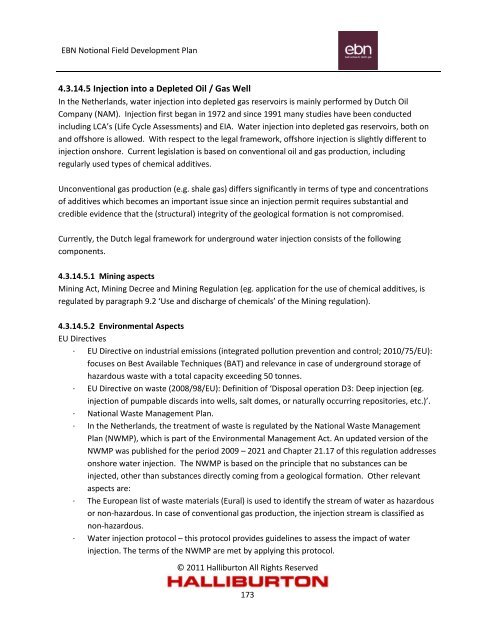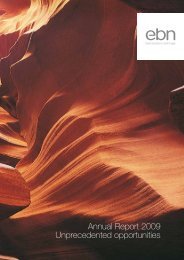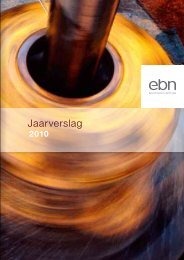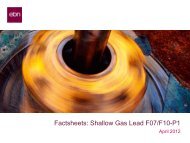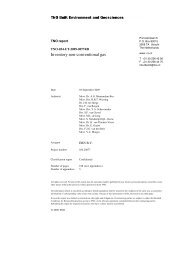Notional Field Development Final Report - EBN
Notional Field Development Final Report - EBN
Notional Field Development Final Report - EBN
You also want an ePaper? Increase the reach of your titles
YUMPU automatically turns print PDFs into web optimized ePapers that Google loves.
<strong>EBN</strong> <strong>Notional</strong> <strong>Field</strong> <strong>Development</strong> Plan<br />
4.3.14.5 Injection into a Depleted Oil / Gas Well<br />
In the Netherlands, water injection into depleted gas reservoirs is mainly performed by Dutch Oil<br />
Company (NAM). Injection first began in 1972 and since 1991 many studies have been conducted<br />
including LCA’s (Life Cycle Assessments) and EIA. Water injection into depleted gas reservoirs, both on<br />
and offshore is allowed. With respect to the legal framework, offshore injection is slightly different to<br />
injection onshore. Current legislation is based on conventional oil and gas production, including<br />
regularly used types of chemical additives.<br />
Unconventional gas production (e.g. shale gas) differs significantly in terms of type and concentrations<br />
of additives which becomes an important issue since an injection permit requires substantial and<br />
credible evidence that the (structural) integrity of the geological formation is not compromised.<br />
Currently, the Dutch legal framework for underground water injection consists of the following<br />
components.<br />
4.3.14.5.1 Mining aspects<br />
Mining Act, Mining Decree and Mining Regulation (eg. application for the use of chemical additives, is<br />
regulated by paragraph 9.2 ‘Use and discharge of chemicals’ of the Mining regulation).<br />
4.3.14.5.2 Environmental Aspects<br />
EU Directives<br />
· EU Directive on industrial emissions (integrated pollution prevention and control; 2010/75/EU):<br />
focuses on Best Available Techniques (BAT) and relevance in case of underground storage of<br />
hazardous waste with a total capacity exceeding 50 tonnes.<br />
· EU Directive on waste (2008/98/EU): Definition of ‘Disposal operation D3: Deep injection (eg.<br />
injection of pumpable discards into wells, salt domes, or naturally occurring repositories, etc.)’.<br />
· National Waste Management Plan.<br />
· In the Netherlands, the treatment of waste is regulated by the National Waste Management<br />
Plan (NWMP), which is part of the Environmental Management Act. An updated version of the<br />
NWMP was published for the period 2009 – 2021 and Chapter 21.17 of this regulation addresses<br />
onshore water injection. The NWMP is based on the principle that no substances can be<br />
injected, other than substances directly coming from a geological formation. Other relevant<br />
aspects are:<br />
· The European list of waste materials (Eural) is used to identify the stream of water as hazardous<br />
or non-hazardous. In case of conventional gas production, the injection stream is classified as<br />
non-hazardous.<br />
· Water injection protocol – this protocol provides guidelines to assess the impact of water<br />
injection. The terms of the NWMP are met by applying this protocol.<br />
© 2011 Halliburton All Rights Reserved<br />
173


